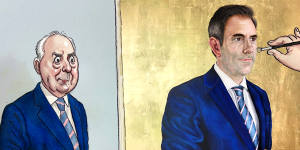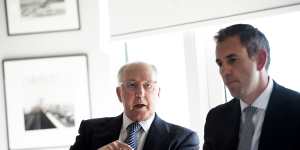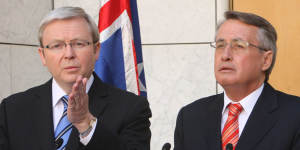The background of gold leaf shimmers with the promise of prosperity although,unusually for a portrait,he’s not looking at you,the viewer,but away to one side,a hint of evasiveness. Can we trust the promise?

Illustration:John Shakespeare
As the artist,Christopher Malouf,carried the painting into the NSW Art Gallery this week,some casual passers-by couldn’t identify the federal treasurer from the lifelike portrait,but the packing room staff recognised him immediately.
“He’s something of an unknown figure as well as being a main public figure,” interprets Malouf. Overall,the impression is of a man not yet fully formed,a personality still in progress.
The contrast with portraits of Chalmers’ friend and mentor,Paul Keating,is striking. The official portrait of the former treasurer and prime minister that hangs in Parliament House radiates power.
Keating’s darkly unflinching gaze conveys his relentless quest for dominance. The background is the same sombre burgundy with which Keating painted his Sydney office,a shade that replicates exactly the inside of a pharaoh’s tomb. This is a persona fully formed at the end of his political life,and it’s fierce. The Keating portrait,by Robert Hannaford,was a finalist in the Archibald in 1998.
Comparisons between the two are inescapable. Every treasurer since Keating has been measured against his record of reform. The galah in every economic pet shop,to paraphrase a Keatingism,cries out for a return to the driving ambition of the Hawke-Keating reform era.
And Chalmers probably is even more conscious than most of the comparison. He’s not only a friend and apprentice to the former Labor leader,he wrote his PhD on Keating’s leadership style. Title:Brawler Statesman.
As Chalmers finalises the federal budget that he’s due to bring down in 10 days,his form,his political persona,grows clearer. Keating liked to flatter himself that he was all about “the big picture”. His acolytes sometimes called him the Big Picture Man.
With the speech Chalmers this week and with his third budget in prospect,we see him developing into a big-picture man. Not because he’s mimicking his Labor predecessor but in his own right.

Because Chalmers is sketching an ambitious new vision for the Australian economy,and a fundamentally different one from the Hawke-Keating construct.
It has to be. The essence of in the ’80s and ’90s was to remove barriers to market forces. Once they’re gone,you can’t knock them down again.
The world has moved on,and so has Australia and its needs. Chalmers said the “fault line is between the nostalgists and the strategists”.
How is it fundamentally different? While Keating and Hawke dramatically shrank the role of the government in the economy,Chalmers’ plan dramatically expands it. The political label the government is using is “Future Made in Australia” and it will be one of the three dominant themes in the budget in a week-and-a-half. The other two are very familiar – restraining government spending so as to avoid inflaming inflation,and helping households with the cost of living.
But is a radical departure. When I put it to Chalmers at the Lowy Institute that “you are turning 40 years of established thinking and ideology and policy on its head”,he didn’t demur.
Keating sold big government-owned corporations such as the Commonwealth Bank,Qantas,Australian Airlines,the major airports,and Commonwealth Serum Laboratories (CSL) in one of the world’s most sweeping privatisations. By contrast,Chalmers’ policy would deploy multibillion-dollar subsidies,grants and loans to create a new wave of government-owned corporations. Not in recreating the old behemoths in banking,airlines or serums but in renewable energy,critical minerals and advanced technology such as quantum computing.
“It’s huge,” observes Rod Sims,a former economic adviser to Bob Hawke and now ANU professor and chair of the Superpower Institute. “It’s the centrepiece of the government’s economic and climate strategies.”
Chalmers has given his project a name:“My predecessor Paul Keating talked about creating Australia’s third economy” following the colonising economy of early settlement then the era of protectionism that followed. Keating’s third phase was one of an open and competitive economy.

Paul Keating and Treasurer Jim Chalmers at an investment roundtable discussion last year.Jeremy Piper
Continued Chalmers:“What we do now in these years can and must create its fourth.”
What is this “fourth economy” he has in mind? Is it a wise response to Australia’s circumstances or is it a cover for a political porkfest of mammoth proportions?
A few weeks ago,Anthony Albanese announced $1 billion in taxpayer support to companies to make solar panels in Australia. This week,he announced almost $1 billion in joint federal and Queensland government money for a US company to make the world’s first commercially useful quantum computer in Brisbane. Many billions more are to follow.
Where is the rigour to be applied to these outlays? We haven’t seen it yet.
Federal Treasurer Jim Chalmers says fresh hostilities in the Middle East are a "genuine threat" to our economy,with any spike in global oil prices set to impact the cost of petrol.
A key precept of the treasurer is that “we were the beneficiaries of calm and consensus” from the end of the Cold War and into the 2000s,“and now we can be the beneficiaries of churn and change”. Not by resisting change but embracing it.
OK,we know the churn and change is afoot in the world. So what’s the response? Massive outlays of government money,from government investment accounts,so they don’t appear in the annual budget balance.
Chalmers says the investments will be highly selective,sorted into two streams. One will be “a national interest stream,where domestic sovereign capability is necessary to protect our national security interests or ensure our economy is sufficiently resilient to shocks”. Funds would go to “only the most critical risks”.
The government is investing billions to make cruise missiles in Australia,which clearly falls into this category. We don’t yet know what else the government plans to include. As Rod Sims points out:“You can justify too much under this heading. There’s a huge number of products we need to import into Australia. You need a very careful assessment.”
The other stream is a “net zero transformation stream,where industries support decarbonisation,and there is a reasonable prospect of a self‑sustaining comparative advantage”.
Sims says the net zero stream is eminently wise. It would deliver on Ross Garnaut’s vision of Australia as a renewable energy superpower,the vision that animates Sims’ Superpower Institute. As the home of the world’s cheapest solar and wind power,Australia would become the planet’s smelter of green iron,green aluminium,green silicon,green urea and so on. Sims says Chinese,Korean and Japanese companies are already sizing up such plans for Australia.
If Australia did all the smelting with renewable energy,it would cut global carbon emissions by 7 to 10 per cent. “No stretch,” says Sims. To get there,however,requires initial government support to correct for a global market failure – the absence of a carbon price.
Yet he’s wary of ill-disciplined government spending here,too. So he was reassured by Chalmers’ listing of five criteria.
According to the treasurer,the tests for any taxpayer investments will be that they’re in an industry where Australia can be competitive,that they contribute to an orderly path to net zero,that they “build the capabilities of our people and especially our regions”,improve Australia’s national security and economic resilience,and recognise the key role of the private sector.
Chalmers said it was his responsibility to deliver “value for money” for the government. He promised that specific mechanisms would be announced in the budget.
This is Chalmers’ big picture. Like the Malouf portrait,it’s larger than life. But the big picture’s greatest vulnerabilities will lie in the details of its execution.
The Rudd government was punished for the bungled detail of its well-meant stimulus spending on school halls and insulation. Turnbull’s Snowy 2.0 is years late and many billions over budget. Likewise,a $30 billion-plus pet Coalition boondoggle,the Inland Rail,which has yet to find a useful destination.

Then-prime minister Kevin Rudd and treasurer Wayne Swan in 2008.Andrew Taylor
If Malouf’s portrait wins the Archibald,he’ll donate a portion of the prize to charity. If Chalmers can deliver on his big picture,Australia will win on a global scale. If not,the title of Malouf’s portrait will be vindicated –Fools’ Gold.
Peter Hartcher is political editor.
Cut through the noise of federal politics with news,views and expert analysis..